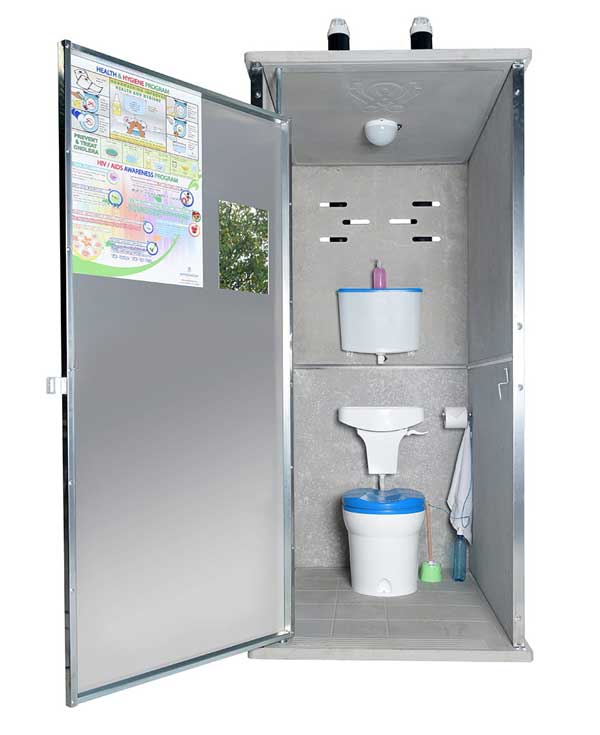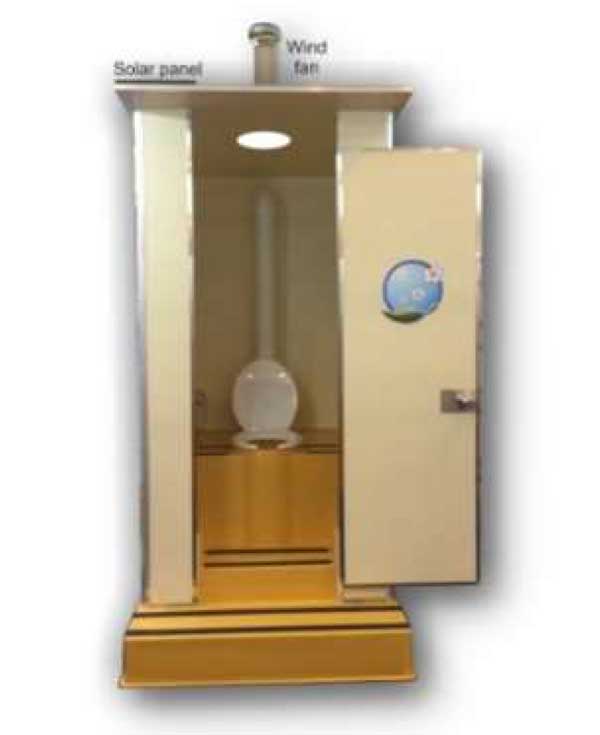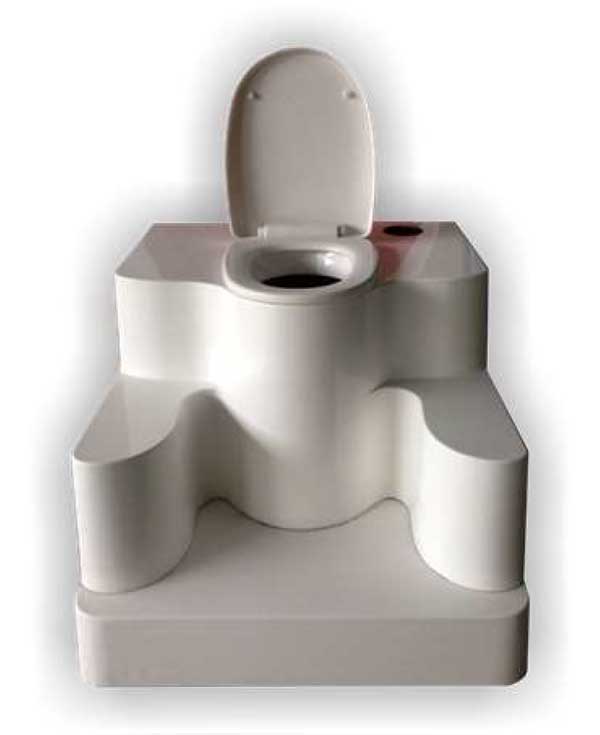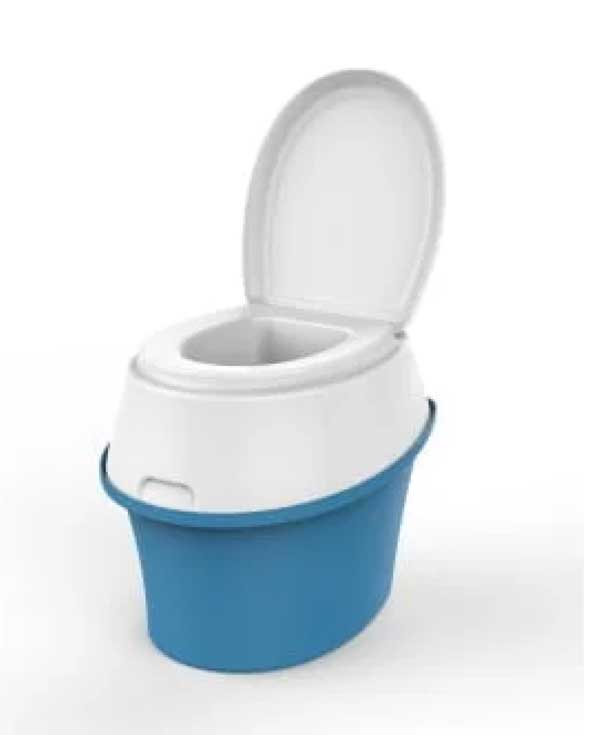Annexure
Descriptions and references to existing innovative sanitation solutions in the market.
Click me!

| Amalooloo – dry sanitation system with liquid separation at the source. |
|---|
| Developer: Betram (PTY) Ltd in South Africa (patented) |
| Global access: South Africa and can be delivered internationally. |
| More information: https://amalooloo.co.za/#product |
Frontend: The front end presents a pedestal with urine diversion for male and female users, where the first liquid separation occurs. The pedestal incorporates a child safety seat and a stepping block for small children. The toilet has a handwashing facility inhouse for health and hygiene purposes.
Treatment & reuse/disposal: Urine and faeces are separated in the toilet bowl. The Urine is removed from the system via an ecological pipe connected to the base of a vegetable garden behind the toilet. Faeces, on the other hand, are contained in a sealed container (in the substructure) right below the toilet superstructure. In this container, the second liquid separation occurs by aeration as cool air enters the pedestal via an air inlet between the pedestal lid and the seat and hot air moves from the sealed container upwards via a vent pipe thus drying the faeces faster. The faeces are raked to the back of the container to dry even faster resulting in a reduced content volume which can be removed annually and used as fertilizer. The system requires minimal emptying since the excreta is treated in situ and is only emptied to remove the by-products for reuse application.
Structure: The substructure is constructed using bricks while the superstructure uses precast slabs.
Ideal context: While it is largely a dry system, developers recommend occasional (and regulated) use of water to enhance hygiene. The technology, therefore, presents a sanitation system for both waterborne and dry (ventilated improved pit) structures.


| Developer: | Ecoloo AB |
|---|---|
| Global access: | Sweden, with opportunities to export (so far exported to 25 countries). |
| More information: | https://ecoloogroup.com/index.htm |
Ecoloo is a stand alone decentralized waterless toilet solution.
Frontend: The Ecoloo toilet presents a pedestal with a toilet seat, toilet lid, dry flush, wind ventilation fan and drop bed where the waste goes. The drop bed is made of a 2-tier box: 1) an upper box where the excreta and enzyme bacteria go to. In this chamber is also placed an organic filter, which separates the liquids from the solids; 2) a lower box where urine and/ or water drop to undergo treatment.
Treatment & reuse/disposal: The system employs a nitrification process for urine treatment, transforming the urine into odorless, pathogen-free natural fertilizer good for agriculture. The faeces, on the other hand, are completely broken down by the enzyme bacteria in the upper box. The toilet does not require regular emptying of the waste except for periodic removal of the treated urine (liquid) fertilizer for application.
Structure: The toilet system is stand alone, above ground and portable, and can therefore be retrofitted in any existing infrastructure (superstructure). Materials used are fiberglass reinforced plastic (RFP) giving the toilet a total weight of 90kgs.
Ideal context: The retrofit-ability of Ecoloo toilet makes it very versatile and suitable for a wide range of contexts regardless of climate/physical conditions or purpose. The system can be used temporarily or permanently depending on need. It is suitable in among other contexts: water scarce areas (little water use recommended for hygiene); high groundwater table areas; rural and urb

| Mosan | |
|---|---|
| Global access: | Guatemala |
| More information: | https://mosan.ch/ |
The Mosan toilet is a container-based sanitation (CBS) system that provides for urine-faeces separation.
Frontend: Mosan’s CBS presents a durable plastic container with a toilet seat, a lid and two containers within the larger container for urine and faeces collection. The urine container has a valve for smell prevention, while the faecal container is used with dry materials such as ash or sawdust to enhance drying and curb smell.
Emptying and transport: The Mosan team provides users with regular collection services where the staff exchange full containers with clean empty ones. Mobile communication, NFC code tracking and sms notification are employed to ensure effective and safe service. After the collection, the Mosan team transports the waste to a transformation centre.
Treatment & reuse/disposal: Urine and faeces are processed separately and transformed into useful by-products. The former is transformed into struvite while the latter is processed in a pyrolysis reactor to produce biochar, which can be used as a soil amendment as well as carbon sequester for reducing greenhouse gases.
Structure: The containers are made of durable plastic material in an ergonomic and elegant design. These can be fitted into any desired superstructure.
Ideal context: The Mosan solution is a CBS system which can be fitted into any desired space including superstructures, for use. Given the size, portability and resource-focussed aspect of the Mosan system, it is suitable in diverse non-sewered contexts including slum and rural areas.
| Developer: | EOOS (patent pending) |
|---|---|
| Global access: | So far trialed in India (squat pan) and Durban, South Africa |
| More Information: | http://www.urinetrap.com/ |
EOOS Urine Trap
Unlike many Urine Diverting Dry Toilets (UDDTs), the EOOS Urine Trap toilet is a urine diversion toilet designed specifically for flush toilets.
Frontend: The frontend presents a combination of a urine diverting flush toilet as a frontend technology and a liquid solid separator. The toilet contains a backend technology that provides for three-stream separation, i.e. urine, fecal solids and fecal water separation.
Treatment & disposal: In order to separate urine, solids, and water for treatment in the backend system, the first treatment step utilizes the “Urine Trap”, which separates urine from the flush water and feces at source i.e. in the bowl of a flushing toilet. The second treatment step involves a liquid-solid separator, which separates the liquid fraction (feces water) from the solids (feces and toilet paper). The 3 waste streams can then be further processed at low-tech depending on the desired end-products, e.g. struvite, liquid fertilizer, compost, biochar and reusable water.
Structure: Made of SATO materials (TBC)
Ideal context: The “Urine Trap” can be universally applied to all typologies of wash-down toilet designs: pedestal or squat pan, cistern flush or pour flush, washers or wipers. Additionally, it does not require energy for separation nor does it require users’ behavioral change, and has the possibility to use low-tech (biological) treatment options for the streams.
| DEVELOPER: | Urimat |
|---|---|
| More Information: | https://www.urimat.com/en/products/urinals |
URIMAT membrane urine trap technology
The Swiss company has patented a membrane trap technology to control Oduor. Urine collected by a urinal bowl is channeled into an odor trap, from the trap the urine passes through a vertical membrane which prevents gasses from escaping storage. The vertical membrane opens up when it senses the presence of urine and does not allow gasses and particles to find their back.
It is ideal for areas where there are challenges with water. Unlike other Oduor trap technologies, you don’t have to change cartridges and it is not affected by cleaning products.
The company also designs waterless urinal bowls with environmentally friendly materials. There are advertising spaces on the toilet bowls that can be used to generate revenue to pay for the bowl.